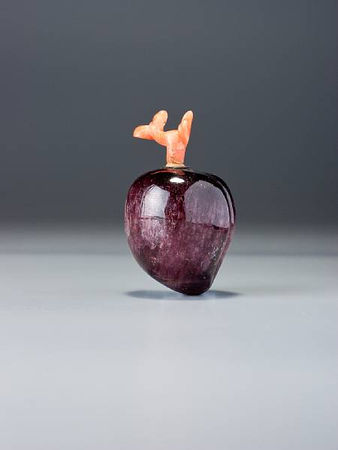The Imperial Birthday Ruby. A ruby and silver 'peach' snuff bottle. Probably Imperial, 1700–1900
The Imperial Birthday Ruby. A ruby and silver 'peach' snuff bottle. Probably Imperial, 1700–1900. photo Bonhams
Ruby with silver; very well hollowed and carved in the form of a peach, the mouth lined with silver. Probably imperial, 1700–1900. Height: 3.58 cm . Mouth: 0.5 cm. Stopper: coral, a fragment of a pendant carved as a fish. Condition: Natural flaws to the underside, nothing too obtrusive; otherwise, in workshop condition. 3.58cm high.- Sold for HK$240,000
Treasury 3, no. 406
Provenance: Robert Hall (1987)
Published: Hall 1987, no. 85
Kleiner 1995, no. 304
Treasury 3, no. 406
Exhibited: British Museum, London, June–October 1995
Israel Museum, Jerusalem, July–November 1997
Commentary: A ruby of this size and depth of colour must have been a considerable rarity. There are so few early ruby bottles that this gem, which is more translucent than any of the others, is likely to have come to imperial attention. Add to that its peach form, the traditional birthday gift to such an extent that the emperor or empress must have been inundated with peaches in a variety of forms every year, and we have an ideal imperial bottle. There is no other indication that it is imperial, however, since it is quite plain and unmarked, as are the few other known early ruby bottles (see the discussion and citations under Sale 1, lot 13).
For a ruby, this bottle is unusually well hollowed and impeccably formed, with equally fine polishing. As Kleiner pointed out, the rather dynamic stopper is a fish diving into the top of the peach. It cannot have been the original and is quite inappropriate, but is sufficiently branch-like to get away with it. A more suitable stopper would be an emerald green jadeite twig, but in its absence an eccentric carp bungee-jumping into a giant peach will have to suffice.
If, as we assume, this is likely to have been a gift on an imperial birthday, the big question has to be for which emperor (or empress). Although we might prefer to associate it with the Qianlong emperor, there is absolutely no evidence whatsoever that it is more likely to have been made for him than for the Empress Dowager late in the Qing dynasty. It might even have been made for the Kangxi or Yongzheng emperors; we simply have nothing by which to judge it sensibly. Ruby was found in the Xinjiang region, but the more likely source is probably Burma; if we could be certain of its origin, we could offer hypotheses about its date. The fact is, however, it matters not a jot who it was made for or when. As Zhou Jixu wrote in his critique on the Yonglu xianjie (see Richard John Lynn's translation in JICSBS, Summer 1995, p. 6):
Do not just talk about how far back in the past it dates from, for, although age is esteemed, we esteem more the close bond the owner forms with a bottle.
With an extraordinary bottle like this, that bond is strong. It is one of the most spectacular ruby bottles known, and as rare and magnificent, whether early eighteenth or late nineteenth century.
聖誕紅寶石
紅寶石及銀;掏膛非常完整;雕成桃子形,口內部有一層銀襯裏
大概為御製品, 1700~1900年
高﹕ 3.58 厘米
口經﹕0.5 厘米
蓋﹕ 雕成魚的珊瑚,墜兒的一碎片
狀態敘述﹕ 底面有自然瑕疵,並不明顯,除此以外,屬出坊狀態
來源:羅伯特.霍爾 (1987)
文獻﹕ : Hall 1987, 編號 85
Kleiner 1995, 編號 304
Treasury 3, 編號 406
展覽﹕ : 大英博物館, 倫敦, 1995年6月~10月
Israel Museum, 耶路撒冷, 1997年7月~11月
說明: 如此透明度高、顏色深 紅寶石一定是引皇帝注目的。而且用桃子形的鼻煙壺當皇帝或皇后的生日禮物是理所當然的,只是無紋無款的煙壺不能證明是御製品 (參見 第一場拍賣會, 拍賣品號 13),也不能推測是甚麼時期作的。但無論如何,是引人入勝的。
Bonhams. Bloch Collection. 23 Nov 2010 to 24 Nov 2010, Hong Kong www.bonhams.com

/https%3A%2F%2Fprofilepics.canalblog.com%2Fprofilepics%2F1%2F0%2F100183.jpg)
/https%3A%2F%2Fstorage.canalblog.com%2F03%2F02%2F119589%2F96711876_o.jpg)
/https%3A%2F%2Fstorage.canalblog.com%2F11%2F31%2F119589%2F94773502_o.jpg)
/https%3A%2F%2Fstorage.canalblog.com%2F20%2F83%2F119589%2F94772815_o.jpg)
/https%3A%2F%2Fstorage.canalblog.com%2F26%2F72%2F119589%2F75604929_o.jpg)
/https%3A%2F%2Fstorage.canalblog.com%2F59%2F60%2F119589%2F26458628_o.jpg)








/http%3A%2F%2Fstorage.canalblog.com%2F35%2F20%2F119589%2F127976932_o.jpg)
/http%3A%2F%2Fstorage.canalblog.com%2F75%2F02%2F119589%2F126540144_o.jpg)
/http%3A%2F%2Fstorage.canalblog.com%2F82%2F50%2F119589%2F126508751_o.jpg)
/http%3A%2F%2Fstorage.canalblog.com%2F16%2F21%2F119589%2F126508682_o.jpg)